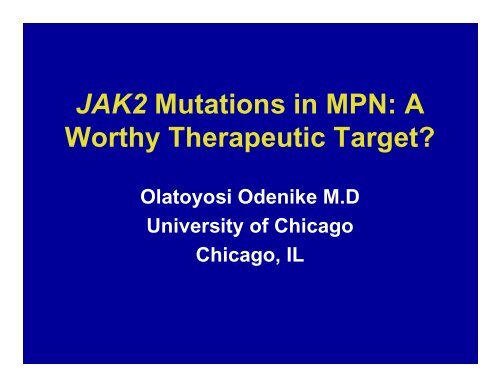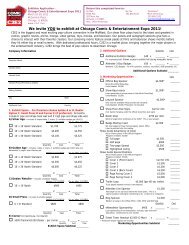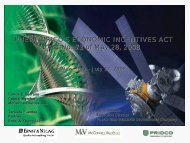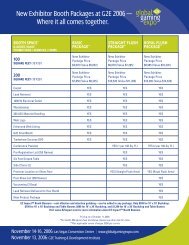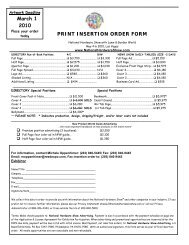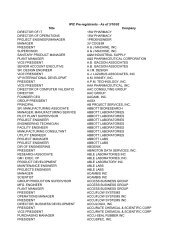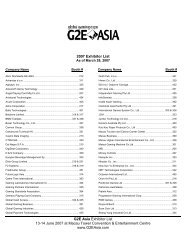JAK2 Mutations in MPN: A Worthy Therapeutic Target?
JAK2 Mutations in MPN: A Worthy Therapeutic Target?
JAK2 Mutations in MPN: A Worthy Therapeutic Target?
You also want an ePaper? Increase the reach of your titles
YUMPU automatically turns print PDFs into web optimized ePapers that Google loves.
<strong>JAK2</strong> <strong>Mutations</strong> <strong>in</strong> <strong>MPN</strong>: A<br />
<strong>Worthy</strong> <strong>Therapeutic</strong> <strong>Target</strong><br />
Olatoyosi Odenike M.D<br />
University of Chicago<br />
Chicago, IL
Conflict of Interest Disclosure<br />
Company<br />
Gloucester<br />
Pharmaceuticals<br />
MGI Pharma/Eisai<br />
Curagen/Topotarget<br />
Celgene, MGI<br />
Pharma, Cephalon,<br />
Genzyme,<br />
Amgen<br />
Relationship<br />
UC Tech Patent<br />
Research Support<br />
Advisory<br />
Board/Consultancy
Phenotypic Mimicry <strong>in</strong> <strong>MPN</strong><br />
• Involvement of pluripotent HSC<br />
• Increase <strong>in</strong> one or more peripheral<br />
blood elements<br />
• Marrow hypercellularity<br />
• Extramedullary hematopoiesis<br />
• Thrombo-hemorrhagic complications<br />
• Predisposition to marrow fibrosis and<br />
leukemic transformation
Recurr<strong>in</strong>g Cytogenetic Abnormalities<br />
<strong>in</strong> <strong>MPN</strong> at Diagnosis<br />
Disease<br />
Specific<br />
Non-specific<br />
%<br />
CML, CP<br />
t(9;22)<br />
>95<br />
CML, AP/BP<br />
t(9;22)<br />
+8, +Ph, +19, i(17q), t(3;21)<br />
80<br />
CNL<br />
none<br />
+8, +9, del (20q), del (11q14)<br />
10<br />
CEL/HES<br />
none<br />
+8, t(5;12), dic(1;7), 8p11<br />
60<br />
PV<br />
none<br />
+8, +9, del (20q), del(13q),<br />
del(9p)<br />
15<br />
PMF<br />
+8, del(20q),-7/del(7q), del(11q),<br />
del(13q), 12pnone<br />
30<br />
ET<br />
none<br />
+8, del(20q)<br />
5
Activat<strong>in</strong>g <strong>Mutations</strong> of Tyros<strong>in</strong>e K<strong>in</strong>ases <strong>in</strong> <strong>MPN</strong><br />
Lev<strong>in</strong>e RL, et al., Nature Reviews Cancer, 2007
<strong>JAK2</strong> <strong>Mutations</strong> <strong>in</strong> <strong>MPN</strong><br />
Exon 12<br />
<strong>Mutations</strong><br />
V617F<br />
<strong>JAK2</strong><br />
FERM Pseudok<strong>in</strong>ase K<strong>in</strong>ase<br />
COOH<br />
• <strong>JAK2</strong> V617F mutation<br />
– S<strong>in</strong>gle nucleotide substitution <strong>in</strong> <strong>JAK2</strong> exon 14 sequence<br />
– Mutation occurs <strong>in</strong> the pseudok<strong>in</strong>ase doma<strong>in</strong> of the prote<strong>in</strong><br />
• <strong>JAK2</strong> exon 12 abnormalities<br />
– <strong>Mutations</strong>, deletions, <strong>in</strong>sertions<br />
• Result <strong>in</strong> constitutive activation of <strong>JAK2</strong> TK
JAK-2 mediated Signal Transduction Pathways<br />
Ligand Bound Receptor<br />
(EPOR, MPL, GCSF)<br />
AKT<br />
mTOR<br />
P<br />
P13K<br />
P<br />
P<br />
<strong>JAK2</strong><br />
P<br />
P<br />
P<br />
STAT<br />
STAT<br />
P<br />
<strong>JAK2</strong><br />
STAT<br />
STAT<br />
P<br />
P<br />
P<br />
RAS<br />
MAPK<br />
<strong>Target</strong> Gene<br />
Activation<br />
Survival<br />
Differentiation<br />
Proliferation
MPL mutations <strong>in</strong> <strong>MPN</strong><br />
• Detected <strong>in</strong> PMF and ET<br />
– 5 to 10% frequency<br />
• Two most common are W515L and<br />
W515K<br />
• Result <strong>in</strong> constitutive activation of JAK-<br />
STAT signal<strong>in</strong>g<br />
• Cause PMF phenotype <strong>in</strong> mice<br />
• Coexistence with <strong>JAK2</strong>V617F has been<br />
described
<strong>JAK2</strong>V617F Mutational Frequency <strong>in</strong><br />
Myeloid Neoplasms<br />
Disease<br />
**Polycythemia Vera<br />
*Essential Thrombocytosis<br />
*Primary Myelofibrosis<br />
CMMOL<br />
RARS-T<br />
Acute Myeloid Leukemia<br />
Frequency (%)<br />
>95%<br />
≈50%<br />
≈50%<br />
3-9<br />
≈40%<br />
Question #1: The <strong>JAK2</strong> V617F allele<br />
frequency is:<br />
a) Greater than 95% <strong>in</strong> Polycythemia<br />
vera<br />
b) Approximately 50% <strong>in</strong> Essential<br />
thrombocythemia<br />
c) Approximately 50% <strong>in</strong> Primary<br />
Myelofibrosis<br />
d) Relatively rare <strong>in</strong> AML<br />
e) All of the above
Diagnostic algorithm for <strong>MPN</strong> <strong>in</strong> <strong>JAK2</strong> Era<br />
<strong>JAK2</strong>V617F genotyp<strong>in</strong>g when a<br />
<strong>MPN</strong> is suspected<br />
Positive<br />
Negative<br />
PV, ET, PMF<br />
Likely<br />
Use additional WHO criteria<br />
PV: unlikely; test for<br />
<strong>JAK2</strong> ex 12<br />
ET or PMF: possible;<br />
test for MPL<br />
Use additional WHO criteria<br />
Adapted from Vannucchi AM et al, CA Cancer J Cl<strong>in</strong> 2009
Question #2: The presence of the<br />
<strong>JAK2</strong>V617F is sufficient to:<br />
a) Establish a diagnosis of Polycythemia<br />
vera<br />
b) Establish a diagnosis of MDS-RARS-T<br />
c) Establish a diagnosis of Primary<br />
Myelofibrosis<br />
d) Rule out a reactive cause of<br />
thrombocytosis<br />
e) Establish a diagnosis of Essential<br />
thrombocythemia
Question # 3:<br />
In a 60 year old smoker with a<br />
hemoglob<strong>in</strong> of 19g/dL and a low serum<br />
erythropoiet<strong>in</strong> level:<br />
a) A diagnosis of Polycythemia vera can be made<br />
unequivocally<br />
b) It is necessary to perform a bone marrow<br />
biopsy to diagnose Polycythemia vera<br />
c) The f<strong>in</strong>d<strong>in</strong>g of a <strong>JAK2</strong>V617F mutation <strong>in</strong> a<br />
peripheral blood sample is diagnostic of<br />
Polycythemia vera<br />
d) Oxygen saturation should be measured to<br />
diagnose the cause of the erythrocytosis<br />
e) A red cell mass should be performed to make a<br />
conclusive diagnosis of Polycythemia vera
The Ideal <strong>Target</strong> for <strong>MPN</strong> Therapy<br />
• Present <strong>in</strong> patients with the disease<br />
• Determ<strong>in</strong>ed to be the causative<br />
abnormality<br />
• Has a unique activity that is<br />
– Required for disease <strong>in</strong>duction<br />
– Dispensable for normal cellular function
Is <strong>JAK2</strong>V617F the <strong>in</strong>itiat<strong>in</strong>g event <strong>in</strong><br />
<strong>MPN</strong><br />
YES<br />
• Confers cytok<strong>in</strong>e <strong>in</strong>dependent<br />
growth and growth factor<br />
hypersensitivity <strong>in</strong> vitro<br />
• Causes PV phenotype <strong>in</strong><br />
mur<strong>in</strong>e models<br />
NO<br />
• <strong>JAK2</strong> positive <strong>MPN</strong> can<br />
transform <strong>in</strong>to <strong>JAK2</strong> negative<br />
AML<br />
• Pre-<strong>JAK2</strong> mutations possible
Pre-<strong>JAK2</strong> mutations<br />
HSC<br />
MPP<br />
Acquisition of<br />
<strong>JAK2</strong> and similar<br />
mutations<br />
TET2<br />
del 20q<br />
Predispos<strong>in</strong>g host genetic<br />
Factors Epigenetic events
One mutation: Multiple phenotypes: Gene dosage effect<br />
Vannucchi AM, Leukemia 2008
<strong>JAK2</strong> mutations and Cl<strong>in</strong>ical<br />
relevance
<strong>JAK2</strong>V617F and Thrombosis<br />
• In ET, V617F mutation is associated with<br />
– Higher Hb and leucocyte count<br />
– Higher <strong>in</strong>cidence of thrombosis and cardiovascular<br />
events <strong>in</strong> homozygous patients<br />
• Several studies have demonstrated an<br />
association with thrombosis <strong>in</strong> <strong>MPN</strong><br />
– Potential confound<strong>in</strong>g variables <strong>in</strong> virtually all<br />
studies<br />
• Significant association with splanchnic ve<strong>in</strong><br />
thrombosis<br />
– Odds ratio; 53.98 (13-222)<br />
Aust<strong>in</strong> SK et al, BJH 2008<br />
Dentali F et al, Blood 2009
<strong>JAK2</strong>V617F and Thrombosis<br />
Carrobio et al, Exp Hematol, 2009
Question #4<br />
You are asked to see a 55 year old woman with<br />
no significant past medical or surgical history<br />
who develops Budd Chiari Syndrome. The<br />
diagnostic work up for hypercoagulability<br />
should def<strong>in</strong>itely <strong>in</strong>clude<br />
a) Bone marrow biopsy<br />
b) Liver biopsy<br />
c) CBC<br />
d) Molecular test<strong>in</strong>g of the peripheral<br />
blood for <strong>JAK2</strong>V617F<br />
e) c and d
<strong>JAK2</strong>V617F allele burden over time<br />
Carrobio et al, Exp Hematol, 2009
<strong>JAK2</strong>V617F and Leukemic<br />
Transformation <strong>in</strong> PMF<br />
Proportion of Patients without Progression to<br />
Leukemic Transformation<br />
1,0<br />
0,8<br />
0,6<br />
0,4<br />
0,2<br />
P=0.02<br />
0 50 100 150 200<br />
Time (months)<br />
V617FC<br />
- V617F -<br />
V617F +<br />
V617F +<br />
Barosi G, Blood 2007<br />
Guglielmelli P, Blood 2009
<strong>JAK2</strong>V617F and Overall Survival<br />
Author<br />
Campbell P, 2005<br />
<strong>in</strong> PMF<br />
N V617F+<br />
(%)<br />
152 55<br />
Association<br />
with Survival<br />
Yes: HR 3.3<br />
(95%CI 1.26-8.68)<br />
Barosi G, 2007<br />
304<br />
63<br />
No<br />
Tefferi A, 2008<br />
199<br />
58<br />
No<br />
Gugliemelli P, 2009<br />
186<br />
68<br />
No
<strong>JAK2</strong>V617F and Overall Survival<br />
<strong>in</strong> PMF<br />
V617F -<br />
V617F -<br />
V617F +<br />
P = .34<br />
V617F +<br />
P = .73<br />
Tefferi A, Leukemia 2008<br />
Guglielmelli P, Blood 2009
Question #5<br />
The presence of the <strong>JAK2</strong>V617F<br />
mutation has been shown to:<br />
a) Initiate myeloproliferative neoplasms <strong>in</strong><br />
humans<br />
b) Contribute to the disease phenotype <strong>in</strong><br />
humans with essential thrombocythemia<br />
c) Cause venous thrombosis<br />
d) Cause leukemic transformation <strong>in</strong> humans<br />
<strong>in</strong> prospective studies<br />
e) Significantly shorten overall survival <strong>in</strong><br />
patients with myeloproliferative neoplasms
<strong>JAK2</strong>V617F allele burden and<br />
survival <strong>in</strong> PMF<br />
P= 0.0008<br />
1 st 2 nd 3 rd<br />
P=0.0001<br />
4 th<br />
Tefferi A, Leukemia 2008 Guglielmelli P, Blood, 2009
<strong>JAK2</strong> <strong>in</strong>hibitors <strong>in</strong> <strong>MPN</strong>
<strong>JAK2</strong> <strong>in</strong>hibitors: Precl<strong>in</strong>ical<br />
• B<strong>in</strong>d to <strong>JAK2</strong> k<strong>in</strong>ase catalytic site at low<br />
nanomolar concentrations<br />
– Both wildtype and mutant allele <strong>in</strong>hibited<br />
• Inhibit the growth of V617F + cell l<strong>in</strong>es and<br />
primary <strong>MPN</strong> cells<br />
– Progenitors from <strong>MPN</strong> patients more<br />
sensitive than healthy controls<br />
• Activity demonstrated <strong>in</strong> mur<strong>in</strong>e models of<br />
V617F+ <strong>MPN</strong>
<strong>JAK2</strong> Inhibitors <strong>in</strong> the cl<strong>in</strong>ic<br />
Agent<br />
CEP701<br />
XL019<br />
TG01348<br />
INCB018424<br />
SB1518<br />
AZD1480<br />
Company<br />
Cephalon<br />
Exelixis<br />
TargeGen<br />
Incyte<br />
S*Bio<br />
AstraZeneca<br />
Biological <strong>Target</strong><br />
<strong>JAK2</strong> and FLT3<br />
<strong>JAK2</strong><br />
<strong>JAK2</strong><br />
JAK1 and <strong>JAK2</strong><br />
<strong>JAK2</strong> and FLT3<br />
<strong>JAK2</strong>
A Phase I Study of XL019, a<br />
Selective <strong>JAK2</strong> Inhibitor, <strong>in</strong><br />
Patients with Primary<br />
Myelofibrosis, Post-Polycythemia<br />
Vera, or Post-Essential<br />
Thrombocythemia Myelofibrosis<br />
Shah et al. ASH 2008
Phase I Study XL019: Safety Data<br />
Related Adverse Events<br />
Non-<br />
Hematologic<br />
AEs<br />
Hematologic<br />
AEs<br />
Formication<br />
Peripheral<br />
Neuropathy<br />
Confusional state<br />
Balance Disorder<br />
Paresthesia<br />
Dysgeusia<br />
Fatigue<br />
Nausea<br />
Sk<strong>in</strong> Rash<br />
Anemia<br />
Thrombocytopenia<br />
Neutropenia<br />
25 mg<br />
(N=16)<br />
n (%)<br />
2(12)<br />
1(6)<br />
1(6)<br />
1(6)<br />
1(6)<br />
1(6)<br />
1(6)<br />
1(6)<br />
1(6)<br />
2 (40)<br />
1(6)<br />
• Dose levels of 25 or 50 mg (N=21)<br />
• No drug-related hematologic adverse events (AEs)<br />
• Asymptomatic NCS changes were observed <strong>in</strong> 3 patients dosed at 25 mg<br />
0<br />
0<br />
0<br />
All Grades<br />
50 mg<br />
(N=5)<br />
n (%)<br />
2(40)<br />
2(40)<br />
1 (20)<br />
0<br />
0<br />
0<br />
0<br />
0<br />
0<br />
0<br />
0<br />
25 mg<br />
(N=16)<br />
n (%)<br />
0<br />
0<br />
0<br />
0<br />
0<br />
0<br />
0<br />
0<br />
0<br />
0<br />
0<br />
Grade 3 or 4<br />
50 mg<br />
(N=5)<br />
n (%)<br />
0<br />
0<br />
0<br />
0<br />
0<br />
0<br />
0<br />
0<br />
0<br />
0<br />
0<br />
0
Phase I/II Study of INCB18424<br />
• Phase I dose escalation<br />
study<br />
– Reduction <strong>in</strong><br />
splenomegaly and<br />
improvement <strong>in</strong><br />
constitutional symptoms<br />
was observed<br />
– Identified 25 mg 2x/day<br />
as maximum tolerated<br />
dose (MTD), with<br />
reversible<br />
thrombocytopenia as the<br />
dose-limit<strong>in</strong>g toxicity<br />
• Expansion Cohort:<br />
– Goals: Establish safety<br />
and efficacy with longterm<br />
dos<strong>in</strong>g 25 mg<br />
2x/day (BID)<br />
- Evaluation of:<br />
•Lower doses<br />
– 10 and 15 mg BID<br />
•Once daily dos<strong>in</strong>g<br />
regimen<br />
Verstovsek et al. ASH 2007 and 2008
Demographics<br />
N 152<br />
Age: Median (Range) 65 (40 – 84)<br />
Male:Female 95:57 (62.5%:37.5%)<br />
Disease Subtype:<br />
PMF<br />
PPV-MF<br />
PET-MF<br />
79 (53.7%)<br />
47 (32.0%)<br />
21 (14.3%)<br />
% <strong>JAK2</strong> Mutation Positive 80.3%<br />
% Transfusion Dependent 31.6%
Treatment-Emergent Laboratory F<strong>in</strong>d<strong>in</strong>gs<br />
15 mg BID<br />
25 mg BID<br />
Toxicity<br />
Grade<br />
Hgb*<br />
(N=26)<br />
Platelets<br />
(N=32 )<br />
Hgb*<br />
(N=29)<br />
Platelets<br />
(N=47)<br />
3<br />
2 (8%)<br />
0<br />
6<br />
(21%)<br />
11<br />
(23%)<br />
4<br />
0<br />
0<br />
1<br />
(3.4%)<br />
3<br />
(6.4%)<br />
*Includes subjects who were transfusion <strong>in</strong>dependent at entry with a > 2 gm Hgb decl<strong>in</strong>e
INCB018424: Safety Summary<br />
• INCB018424 was generally well tolerated,<br />
with few adverse events other than<br />
mechanism-based effects on<br />
hematopoiesis<br />
– 115/154 patients (<strong>in</strong>clusive of all Phase<br />
I and s<strong>in</strong>gle daily dose patients) rema<strong>in</strong><br />
on study with a median duration of 12<br />
months<br />
• Myelosuppression was readily reversible<br />
with dose <strong>in</strong>terruption and/or reduction
Impact on Spleen Size Measured by Palpation<br />
Spleen Size, cm<br />
22.5<br />
20.0<br />
17.5<br />
15.0<br />
12.5<br />
10.0<br />
10 mg BID<br />
N=23 to Start<br />
15 mg BID<br />
N=32 to Start<br />
25 mg BID<br />
N=39 to Start<br />
N=11<br />
7.5<br />
5.0<br />
2.5<br />
N=19<br />
N=15<br />
N=9 N=5<br />
0.0<br />
0 56 112 168 224 280 336<br />
Days on Therapy
Spleen Volume Decrease by MRI Parallels<br />
Spleen Size Reduction by Palpation<br />
Proportion Achiev<strong>in</strong>g Response<br />
100<br />
75<br />
50<br />
25<br />
50% size reduction by palpation<br />
(Cl<strong>in</strong>ical Response by IWG<br />
Criteria) corresponds to 35%<br />
volume reduction by MRI<br />
56%<br />
22/39<br />
52%<br />
12/23<br />
50%<br />
12/24<br />
LIVER<br />
LIVER<br />
SPLEEN<br />
BEFORE<br />
THERAPY<br />
AFTER<br />
6 MONTHS<br />
0<br />
25 mg BID/Palpation<br />
15 mg BID/Palpation<br />
15 mg BID/MRI<br />
SPLEEN<br />
53% decrease<br />
In spleen<br />
volume, 32%<br />
decrease <strong>in</strong><br />
liver volume
INCB018424 Improves Splenomegaly<br />
Independent of <strong>JAK2</strong> Mutation Status<br />
Spleen length, cm<br />
22.5<br />
20.0<br />
17.5<br />
15.0<br />
12.5<br />
10.0<br />
7.5<br />
5.0<br />
2.5<br />
JAK mutation POSITIVE; N = 33<br />
JAK mutation NEGATIVE; N = 6<br />
0<br />
0 56 112 168 224 280 336<br />
Time on Therapy (days)<br />
Note: 25mg BID cohort; data are censored after a dose change.
Decrease <strong>in</strong> <strong>JAK2</strong>V617F Allele Burden<br />
100<br />
N=19<br />
P=0.0001<br />
V617F (% Basel<strong>in</strong>e)<br />
90<br />
80<br />
70<br />
100<br />
90<br />
80<br />
70<br />
N=20<br />
P=0.0005<br />
N=14<br />
P=0.016<br />
N=14<br />
P=0.040<br />
N=20<br />
P=0.0007<br />
15mg BID<br />
25mg BID<br />
N=17<br />
P=0.023<br />
N=20<br />
P=0.047<br />
N=16<br />
P=0.041<br />
N=3<br />
N=16<br />
P=0.039<br />
0 84 168 252 336 420 504<br />
Days on Therapy<br />
N=17<br />
P=0.024 N=15<br />
P=0.017<br />
N=12<br />
P=0.033
Rapid Improvement <strong>in</strong> Constitutional Symptoms<br />
Bone Pa<strong>in</strong><br />
Pruritis<br />
Night Sweats<br />
Symptoms Associated<br />
with Elevated Cytok<strong>in</strong>es<br />
Fatigue<br />
Impaired Appetite<br />
Impaired Ability to Bend<br />
Impaired Ability to Move<br />
Symptoms Associated<br />
with Splenomegaly<br />
Abdom<strong>in</strong>al Discomfort<br />
0<br />
10<br />
20<br />
30<br />
40<br />
50<br />
60<br />
70<br />
80<br />
Proportion of Patients with ≥ 50% Improvement<br />
• Myelofibrosis Symptom Assessment Form (MFSAF) used (N=55 respondents)<br />
• Improvement <strong>in</strong> symptoms were seen as early as 2 weeks
Clonal megakaryocyte<br />
Proliferation<br />
Cytok<strong>in</strong>es <strong>in</strong> MF<br />
PDGF<br />
bFGF<br />
TGF-β<br />
Clonal monocyte and<br />
histiocyte proliferation<br />
bFGF<br />
Reactive fibroblast<br />
proliferation and fibrosis<br />
bFGF<br />
TNF-α<br />
bFGF<br />
VEGF<br />
Neoangiogenesis<br />
VEGF<br />
bFGF<br />
TNF-α<br />
TGF-β<br />
TGF-β<br />
Osteosclerosis<br />
TGF-β<br />
Ineffective erythropoiesis<br />
TGF-β<br />
Tefferi A. N Engl J Med 342:1255, 2000
Reduction <strong>in</strong> Pro-Inflammatory Cytok<strong>in</strong>es<br />
V617F+<br />
V617F-<br />
PPV<br />
PMF<br />
PET<br />
PPV<br />
PET<br />
fold change<br />
11<br />
6<br />
3<br />
1.5<br />
-1.5<br />
-3<br />
-6<br />
-11<br />
Basel<strong>in</strong>e<br />
Day 28 on<br />
Therapy
Question # 6<br />
At this current stage of cl<strong>in</strong>ical trial<br />
development, <strong>JAK2</strong> <strong>in</strong>hibitors<br />
should be considered for:<br />
a) All patients with <strong>JAK2</strong> V617F + Essential<br />
thrombocythemia<br />
b) All patients with <strong>JAK2</strong> V617F + Polycythemia<br />
vera<br />
c) All patients with <strong>JAK2</strong> V617F+ Primary<br />
Myelofibrosis<br />
d) Patients with symptomatic Primary<br />
myelofibrosis or post-ET or post-PV<br />
myelofibrosis<br />
e) None of the above
<strong>JAK2</strong> <strong>in</strong>hibitors- hype versus hope<br />
• Several compounds under current <strong>in</strong>vestigation<br />
• Lead compounds so far have uniformly had<br />
favorable effects on spleen<br />
– but have been myelosuppressive or neurotoxic and<br />
several are still <strong>in</strong> dose f<strong>in</strong>d<strong>in</strong>g phase<br />
• S<strong>in</strong>ce <strong>JAK2</strong> is critical for normal hematopoietic<br />
signal<strong>in</strong>g<br />
– therapeutic <strong>in</strong>dex may improve with <strong>in</strong>hibitors that<br />
target mutant allele<br />
• Identification of other key pathogenetic factors<br />
will be essential for the development of optimal<br />
targeted therapeutic approaches


